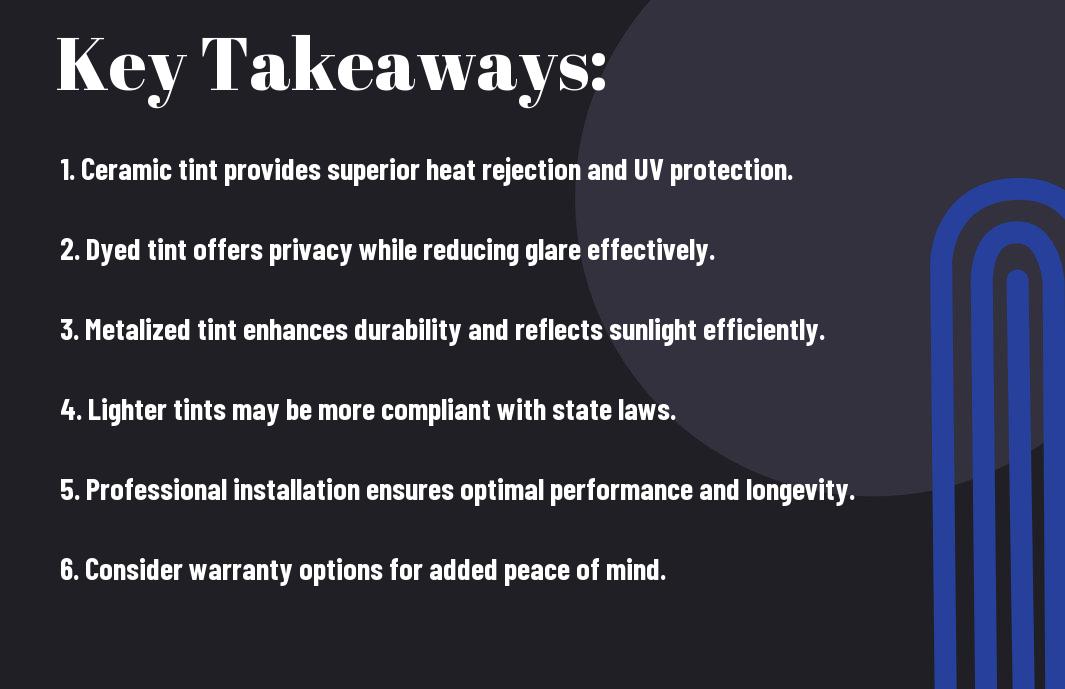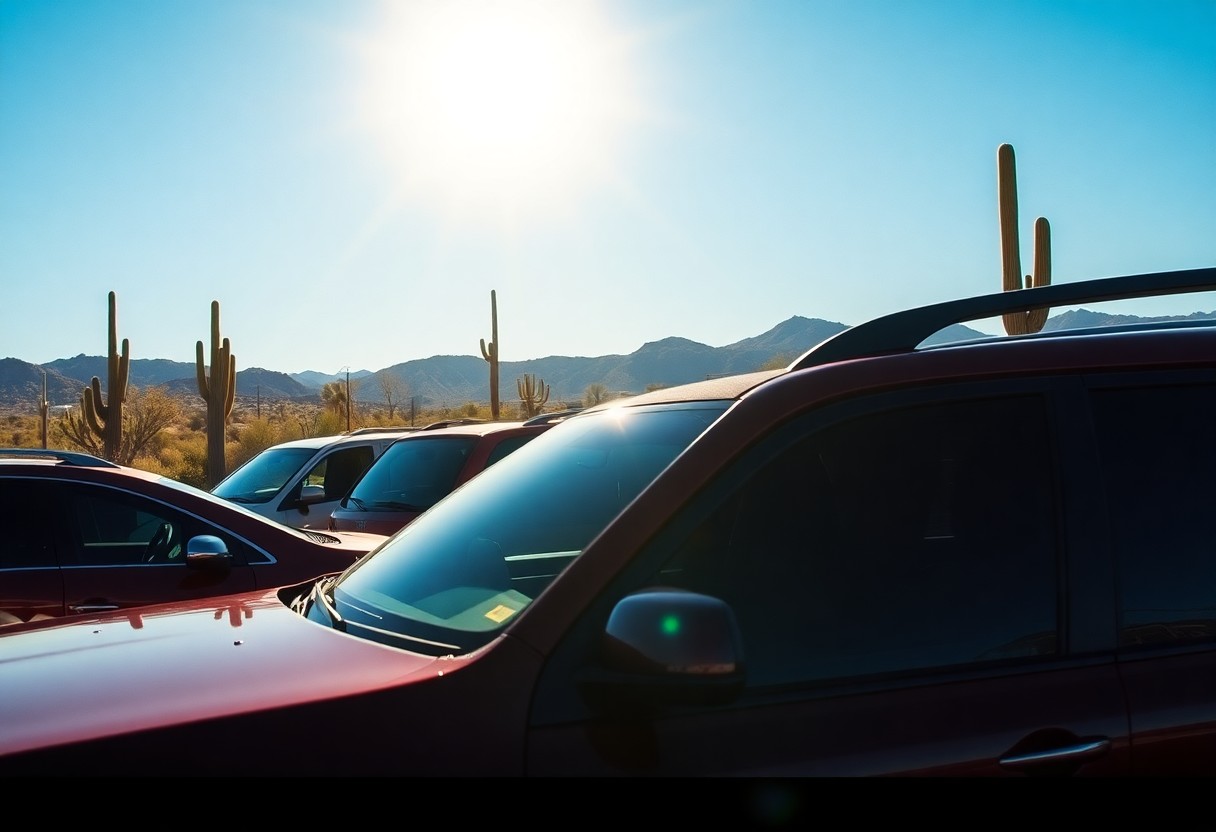With Arizona’s extreme heat, choosing the right window tint can make a significant difference in your comfort and energy savings. The right tint not only protects your interior from harmful UV rays but also helps keep your home or vehicle cooler, reducing reliance on air conditioning. In this post, you’ll discover the best options tailored specifically for your needs. Don’t miss out on expert advice in our guide on Choosing the Right Window Tint for Arizona’s Climate to ensure your investment pays off.
Key Takeaways:
- Heat Resistance: Choose window tinting that offers superior heat rejection to keep your vehicle or home cool during Arizona’s intense summers.
- UV Protection: Opt for window films that provide robust UV protection to safeguard against harmful rays and reduce fading of interiors.
- Legal Compliance: Be aware of Arizona’s window tinting laws to ensure your choices meet state regulations for tint darkness and reflective properties.
Understanding Window Tinting
While many homeowners in Arizona seek relief from the relentless heat, understanding window tinting allows you to make informed choices. It’s not just about aesthetics; the practical advantages of window tinting can significantly improve your indoor comfort and safety.
What is Window Tinting?
At its core, window tinting involves applying a thin film to your windows, which can either be a clear or tinted layer. This film is engineered to reduce the amount of sunlight that penetrates your glass, controlling heat and UV rays. The technology behind window tinting has evolved, offering options that not only enhance privacy but also boost energy efficiency in your home.
This added layer serves multiple purposes—acting as a barrier against high temperatures, harmful UV radiation, and even reducing glare that can be distracting during sunny days. With various shades and qualities available, you can customize the level of tint to suit your personal preferences and needs.
Benefits of Window Tinting
About the benefits you can expect from window tinting, this process can lead to substantial energy savings by reducing the workload on your air conditioning system. With less heat entering your home, you’ll likely notice a decrease in cooling costs over time. In addition to financial savings, effective window tinting significantly protects your furniture and flooring from fading, which is especially important in Arizona’s sun-soaked environment.
Alongside energy savings and protection, window tinting enhances your home’s comfort. By minimizing temperature fluctuations and providing a more uniform climate, you can enjoy a cooler living space during blistering summer days. Moreover, the film can add an extra layer of safety by holding shattered glass together in the event of an accident.
Further, consider that window tinting can elevate your home’s aesthetic appeal. With a variety of shades to choose from, you can select a finish that complements your property style while ensuring your personal privacy.
Common Myths About Window Tinting
By addressing common myths surrounding window tinting, it’s easier to see why some people hesitate to invest in it. One misconception is that all window tints are dark and hinder visibility; however, many options exist that offer high visibility while still blocking harmful UV rays. Furthermore, some believe that installing window tint is a hassle, but with professional services, the process is typically quick and efficient.
Another myth perpetuated is that window tinting can interfere with your electronic devices, such as cell phone signals and GPS; this is generally not true, as most modern films are designed to allow these signals to pass unhindered. Dispelling such myths helps you to understand the full range of benefits that window tinting offers.
About the common myths regarding window tinting, taking the time to research and understand your options can lead to an informed decision. With the right knowledge, you can confidently select the best tint to match your lifestyle and effectively combat Arizona’s harsh weather conditions.

Arizona’s Climate and Its Challenges
If you live in Arizona, you’re no stranger to the extreme weather conditions that come with the desert climate. From blistering hot summers to sudden downpours during the monsoon season, this unique environment presents a variety of challenges, especially when it comes to protecting your home and vehicle from harsh elements.
Overview of Arizona’s Weather
For those in Arizona, summer temperatures often soar past 100°F, making it necessary to find effective ways to combat the heat. With long stretches of sunny days, UV radiation can be relentless, relentlessly impacting your home, car, and personal health. Winters, while milder, can still present challenges with cooler evenings and fluctuating temperatures that require adequate preparation.
The Impact of Sun Exposure on Vehicles
Weather can severely affect your vehicle, causing the interior to heat up to unbearable levels. When your car is parked in direct sunlight, temperatures inside can reach as high as 160°F, leading to rapid deterioration of materials, fading of upholstery, and electronic system failures. Prolonged sun exposure not only takes a toll on your vehicle’s aesthetics but also impacts performance and longevity.
This effect is compounded when you factor in the potential for damaging UV rays that penetrate your vehicle’s windows. Without adequate protective window tinting, the interior features of your vehicle—from leather seats to dashboards—can suffer wear and tear, costing you in repairs down the line.
Health Risks Associated with UV Radiation
The rising concern about UV radiation isn’t just limited to your vehicle’s condition; it also poses potential health risks for you, particularly if you’re often outdoors or spend long periods in your vehicle. Prolonged exposure to UV rays has been linked to various skin issues, including sunburn and premature aging, as well as more serious conditions such as skin cancer. The risk increases significantly for individuals who do not take precautions against UV exposure.
Arizonas residents must be especially vigilant about protecting their skin while driving or spending time outdoors. Investing in high-quality window tint can help minimize your exposure to harmful UV rays, offering you both comfort and health benefits. Not only does window tint improve the overall living experience in your vehicle, but it also acts as a defensive barrier against these significant health risks.

Types of Window Tinting Films
Not every window tinting film is created equal, especially in a place like Arizona where the sun’s rays can be intense. Understanding the different types of window tinting films available can help you make the best choice for your vehicle or home. Here’s a breakdown of the primary options:
| Type | Description |
| Dyed Window Tint | Provides a color change to glass and reduces glare. |
| Metalized Window Tint | Offers enhanced durability and heat rejection. |
| Ceramic Window Tint | High-performance film that blocks UV rays and heat. |
| Hybrid Window Tint | Combines dyed and metalized films for balanced performance. |
| Clear Window Film | Protects against UV rays without darkening the glass. |
Dyed Window Tint
One of the most popular choices, dyed window tint is well-regarded for its ability to provide an aesthetic appeal without breaking the bank. This type of film incorporates dye that darkens the glass, effectively reducing glare and enhancing privacy. However, while it does block some sunlight, it may not provide the same level of heat rejection as other options.
The installation of dyed window tint is relatively straightforward, and its affordability makes it a go-to for many. Despite its advantages, it’s necessary to note that the lifespan of dyed films may be less than that of more advanced options. Continuous exposure to sunlight can lead to fading over time, making periodic replacement necessary.
Metalized Window Tint
With metalized window tint, you benefit from enhanced durability and superior heat rejection. This film contains tiny metallic particles that reflect sunlight away from your vehicle or home, which can significantly reduce interior temperatures. Not only does this help in maintaining comfortable living conditions, but it also implies that your air conditioning system won’t have to work as hard, potentially lowering your energy bills.
The metal composition of this tint provides additional protection against shattering, making it a safer choice for those in high-risk areas. However, you should be aware that some metallic films can interfere with electronic signals, including cell phones and GPS devices.
Plus, the reflective nature of metalized window tint not only enhances privacy and increases interior comfort but also gives your vehicle a sleek appearance. Its durability ensures that it maintains its color and effectiveness for years to come.
Ceramic Window Tint
On the higher end of the spectrum, ceramic window tint offers advanced technology that makes it one of the best options for Arizona’s climate. It utilizes non-metallic, nano-ceramic particles that reflect heat while leaving visible light intact. This feature allows for greater benefits in terms of visibility and comfort without compromising on UV protection.
The superior performance of ceramic window tint also means that it blocks more than 99% of harmful UV rays, protecting both your skin and your interiors from fading and damage caused by prolonged sun exposure.
Hence, when investing in window films, ceramic window tint is a strong contender for those seeking longevity and performance in a single solution. It may come with a higher price tag, but the long-term benefits often outweigh the initial cost.
Hybrid Window Tint
Tint products like hybrid window tint combine the best attributes of both dyed and metalized films. By integrating the dye layer with metal, this option aims to offer extensive heat rejection and enhanced aesthetics, making it a popular middle-ground choice. The added metal content enhances durability and shatter resistance while the dye assists in glare reduction.
The unique combination of materials in hybrid window tint makes it versatile for various applications. Whether it’s for your vehicle or home, the film manages to deliver both performance and style, effectively blocking heat while providing a subtle tint for privacy.
Window enthusiasts appreciate hybrid window tint for its balance between cost and efficiency, making it a reliable option without sacrificing performance or appearance.
Clear Window Film
Film your windows with clear window film if you’re looking for a solution that allows natural light while still providing UV protection. This film is virtually invisible and doesn’t darken your glass, making it a favorite for those who want to maintain visibility without compromising on protection. It effectively blocks harmful UV rays and reduces heat without altering the appearance of your windows.
Many homeowners opt for clear window film to protect furnishings, floors, and skin from sun damage without the aesthetics of tinted windows. It’s an excellent choice for those who want to improve comfort without drastically changing the look of their property.
And, the maintenance of clear window film is straightforward, as it doesn’t show fingerprints or dirt as readily as darker films. This keeps your windows looking clean and clear while still benefiting from the protective properties of window films.
Recognizing the different types of window tinting films available allows you to make a well-informed decision suited to Arizona’s hot climate. Whether you’re looking for aesthetics, heat rejection, UV protection, or affordability, each option has its unique advantages to consider.
Legal Considerations for Window Tinting in Arizona
Now that you understand the benefits of window tinting in Arizona’s intense heat, it’s necessary to consider the legal ramifications of your choices. Ensuring that your window tint adheres to state laws can save you from potential fines and complications. Arizona has specific regulations regarding window tinting, and being informed about them can help you make a decision that aligns with both your aesthetic preferences and the law.
Arizona Window Tint Laws
Below, you’ll find that Arizona law regulates the amount of visible light that can penetrate your vehicle’s windows, which includes both the front and rear windows. The laws are designed to ensure safety while allowing for enough flexibility for you to enjoy the benefits of tinting. Violating these laws can lead to citations and may require you to remove the tint.
Film Darkness Restrictions
On the subject of film darkness restrictions, Arizona sets specific limits on the percentage of visible light transmission (VLT) that your window tints can have. The law generally permits a maximum of 35% VLT on front side windows, while the rear side and back windows can be tinted to a much darker level, including complete blackout options. Understanding these limitations is necessary before choosing your window film.
Darkness laws can differ depending on what windows you’re tinting, so it’s important to check the latest guidelines available from the Arizona Department of Transportation. The law allows you to tint, but you should also consider how darker films may affect visibility during nighttime driving.
Windshield Tint Regulations
Regulations concerning windshield tinting in Arizona are a bit more stringent. You are allowed to apply a non-reflective tint above the manufacturer’s AS-1 line or the top 5 inches of the windshield, allowing for improved visibility without infringing on safety codes. However, going beyond the allowed area could lead to disputes with law enforcement.
To ensure compliance with these windshield tint regulations, it is advisable to consult local laws or a professional installation service that is knowledgeable about Arizona’s tinting rules. Doing so can help mitigate the risk of having to remove your tint or facing fines for improper installations.
Choosing the Right Window Tint
Once again, selecting the ideal window tint can make a significant difference in your comfort and energy efficiency, especially in Arizona’s hot climate. Choosing the right window tint not only helps keep your interior temperatures down but also reduces glare and protects your furnishings from fading. As you navigate through the multitude of available options, it’s important to weigh several factors that directly affect the performance and satisfaction of your window tinting choice.
Factors to Consider
Among the many factors to consider when selecting window tint, the following are integral in ensuring you make the best decision for your needs:
- UV Protection: Opt for films that block a high percentage of harmful UV rays.
- Heat Rejection: Look for tints that effectively reduce solar heat gain.
- Visible Light Transmission: Choose a tint that balances light and privacy according to your preference.
- Legal Regulations: Ensure your tint complies with Arizona’s state laws regarding window darkness.
- Brand Reputation: Research and select established brands known for quality and durability.
Thou should focus on these aspects to ensure you invest in a product that meets your lifestyle and needs.
Climate-Specific Recommendations
Before making your final decision, you should also take into account the specific climate conditions found in Arizona. The state is notorious for its relentless sun and soaring temperatures, making it vital to prioritize window tints that offer optimal heat and UV protection. Consider choosing a high-performance ceramic or metallic film, as these types provide excellent heat rejection without sacrificing visibility.
Factors like the orientation of your windows also play a role in your decision-making process. For instance, south- and west-facing windows receive the most sun exposure, so opting for a darker tint on that side of your home could significantly enhance your indoor comfort during the summer months. It’s wise to customize your approach based on the unique characteristics of your home and the climate of your specific area.
Evaluating Quality and Durability
Around Arizona’s extreme weather conditions, the quality and durability of your window tint cannot be overlooked. Poor quality films may bubble or fade over time, leading to a less appealing appearance and diminished effectiveness. It’s imperative to examine the manufacturer’s warranty and product lifespan to gauge the durability of the film you’re considering.
The longevity of window tint should include considerations such as the adhesive quality and the type of materials used in the film construction. Products that employ advanced technologies, such as nano-ceramic films or high-performance metals, typically offer enhanced durability, ensuring your investment lasts against Arizona’s harsh climate.
Installation Process
For anyone considering window tinting in Arizona’s hot climate, understanding the installation process is crucial to ensuring the longevity and effectiveness of your tint. The way you approach this installation can greatly affect the final result, so it’s important to weigh your options. You have two main choices when it comes to installation: professional services or Do-It-Yourself (DIY) methods. Each comes with its own set of benefits and challenges that you should consider before making a decision.
Professional vs. DIY Installation
Along the lines of convenience and expertise, hiring a professional to handle your window tinting can take a lot of pressure off your shoulders. Professionals come equipped with the right tools, a thorough understanding of the various tinting materials, and the skills needed to avoid common pitfalls that arise during installation. This option often leads to a smoother finish and guarantees that your windows comply with local tinting laws.
On the other hand, if you decide to go the DIY route, you could save money and take pride in handling the project yourself. With numerous kits available on the market, some require minimal experience, making it easier than ever to apply window film. However, be aware that improper installation can lead to bubbles, peeling, or even legal issues if local regulations aren’t adhered to, which can end up costing you more in the long run.
Steps Involved in Professional Installation
Below are the key steps a professional typically follows for an effective window tint installation. First, they will assess your windows to recommend the appropriate type of film based on your preferences and local regulations. Next, the windows are thoroughly cleaned to remove any dirt, grease, or residue that could interfere with the adhesion of the film. After that, the film is meticulously cut and applied to ensure a perfect fit, followed by trimming and sealing the edges for a polished look.
But it doesn’t stop there; professionals usually take the time to educate you on the curing process. This period, typically 3-5 days after installation, is when the film attains optimum adhesion. During this time, avoid rolling down your windows or cleaning them to ensure that they cure properly and prevent potential damage.
Maintenance Tips for Longevity
Across the lifetime of your window tint, proper maintenance will play a significant role in its durability. To keep your tint looking fresh and effective, avoid using abrasive cleaners or materials that could scratch or damage the film. Stick to gentle, ammonia-free cleaning solutions and soft cloths. Additionally, it’s wise to keep your car parked in shaded areas or use sunshades whenever possible to further protect the tint from prolonged sun exposure.
- Use only gentle cleaners to prevent scratches.
- Avoid abrupt temperature changes that can weaken adhesion.
- Regularly clean the tint using a soft cloth.
This attention to detail helps maintain the appearance and functionality of your tint, allowing you to enjoy its benefits for many years.
Plus, regular maintenance also involves an inspection for peeling or bubbling. If you notice any issues, addressing them sooner rather than later is crucial. Make sure to avoid leaving dirt or debris accumulated on the film, as this can accelerate wear and tear.
- Regularly inspect for signs of damage.
- Keep the tinted surface free of debris and dust.
This proactive approach ensures that you maximize the effectiveness and lifespan of your window tint, making it a worthy investment for your vehicle or home.
To wrap up
Considering all points, choosing the right window tint for Arizona’s hot climate is necessary for enhancing your comfort and protecting your vehicle or home from harsh sunlight. You have a variety of options available, from ceramic to hybrid tints, each offering distinct benefits tailored to your specific needs. While both heat rejection and UV protection are critical, the choice also involves considering factors such as aesthetics, warranty, and longevity. By investing in a high-quality tint, you can drastically reduce heat buildup, lower energy costs, and prolong the lifespan of your interior furnishings.
Ultimately, the best window tinting option for you will depend on your specific preferences and requirements. Take the time to evaluate your choices and perhaps consult with professionals to ensure that you select a tint that not only meets legal standards but also provides the level of protection and comfort you desire. In Arizona’s climate, the right window tint can make a significant difference, allowing you to enjoy the great outdoors without the oppressive heat indoors.
Q: What are the benefits of window tinting for homes in Arizona’s hot climate?
A: Window tinting offers several advantages for homeowners in Arizona. First, it significantly reduces the amount of heat that enters through windows, which can lead to lower energy bills by decreasing the reliance on air conditioning. Additionally, window tinting blocks harmful UV rays, protecting indoor furnishings and flooring from fading. It also enhances privacy and can improve safety by holding glass together in the event of breakage.
Q: What types of window tint are most effective for Arizona’s extreme temperatures?
A: In Arizona’s hot climate, ceramic and metallic window tints are highly effective options. Ceramic tints offer excellent heat rejection while maintaining visibility, making them popular among homeowners. Metallic tints also provide impressive heat and glare reduction but can interfere with electronic signals, so this should be considered for homes with satellite TV or internet systems.
Q: Are there any legal restrictions regarding window tinting in Arizona?
A: Yes, Arizona has specific regulations regarding window tinting to ensure safety and visibility. For passenger vehicles, front windshields must allow more than 33% light in, and the front side windows must meet similar requirements. On the other hand, the back side and rear windows have fewer restrictions. For residential properties, it’s important to check with local ordinances, as some areas may have guidelines on the maximum allowable tint darkness. Consulting with a professional can help navigate these regulations.






One thing I’d like to reply to is that fat reduction plan fast can be carried out by the proper diet and exercise. Ones size not just affects appearance, but also the general quality of life. Self-esteem, despression symptoms, health risks, plus physical abilities are affected in weight gain. It is possible to make everything right but still gain. Should this happen, a medical problem may be the primary cause. While an excessive amount food instead of enough work out are usually accountable, common health conditions and widespread prescriptions may greatly increase size. Thanks a bunch for your post here.
We are dedicated to providing quality Luxury airport transfers, including comfortable and reliable limousine services. We service all over Dubai city.